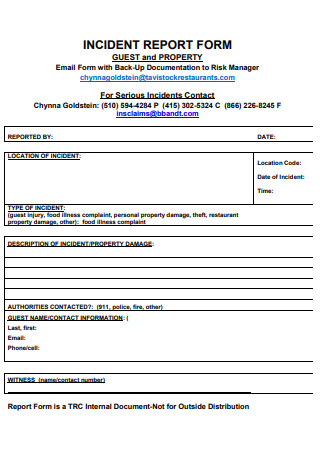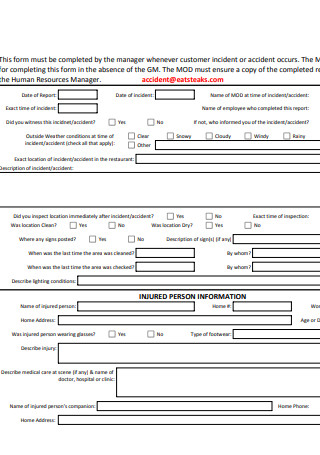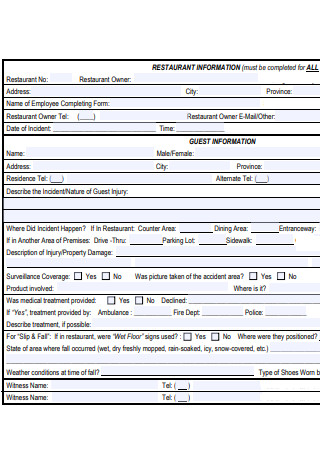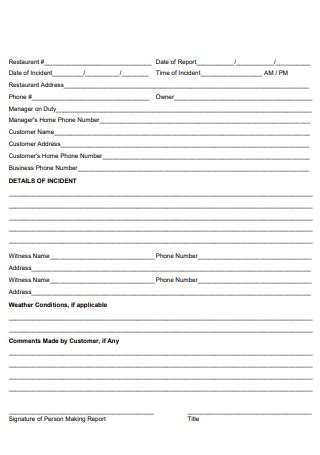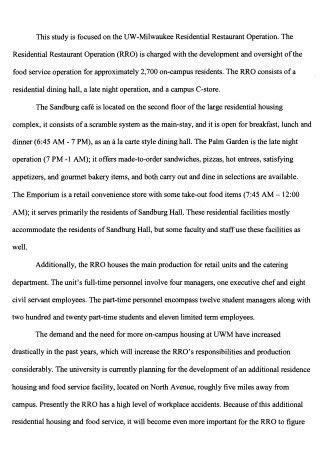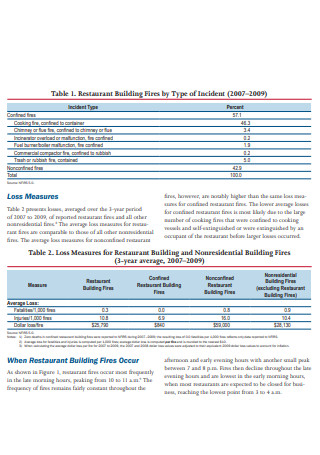5+ SAMPLE Restaurant Incident Report
FREE Restaurant Incident Report s to Download
5+ SAMPLE Restaurant Incident Report
What Is a Restaurant Incident Report?
How to Manage Restaurant Incidents?
The Nitty Gritty When Creating a Restaurant Incident Report
FAQs
What are some of the different kinds of incident reports?
What is the main purpose of writing a restaurant incident report?
What are some of the evidence or proof needed when writing the restaurant incident report?
What Is a Restaurant Incident Report?
Let us first find out the meaning of an incident report. Safeopedia defines an incident report as a formal documentation detailing all the facts relating to an incident that happened at the workplace. The incident can be in the form of an accident or injury, or any type of threat of incident relating to the workers’ safety and well-being in the workplace, the overall restaurant’s safety, including the affected parties in the incident such as the customers or clients. In the case of a restaurant incident report, parties involved could be the management, chefs, kitchen staff, servers or waiters, and the customers. In the restaurant scenario, incidents could be in the form of accidents such as slipping on a wet floor, food poisoning, threats within workers or occurring misdemeanors, a kitchen staff has forgotten to turn off the fire at a gas range and could have cause fire risk, even customer complaining about their food or the servers attitude.
It could also include equipment malfunctioning, or lack of safety equipment in place, or even a psychological traumatic incident for the workers and customers when they’re inside the restaurant. All the circumstances that took place leading up to the incidents should be detailed in the restaurant incident report. A restaurant incident report is based on the prevailing policies and guidelines that details procedures to be done in an event that led to the injury, or threatened the health and safety of everyone inside the restaurant, including the employees and its customers. The investigation of the incident is usually done by the restaurant manager since they are tasked to oversee the restaurant’s whole operation. Accurate and timely reporting is important when making a restaurant incident report so that it could immediately assess the situation, provide necessary resolution before the issue goes out of hand, or what you call as a damage control, and provide measures in place that would prevent the same incident from happening again. The incident report documentation helps in identifying future risk and failures, setting up corrective measures in place.
How to Manage Restaurant Incidents?
Although you may have the best guidelines and policies in place in your restaurant as an owner or as a manager, you still need to prepare for unforeseeable incidents. Aside from having a good action plan, you also need to know how to respond when these events occur. Here are some of the ways on how you can manage the restaurant when an incident arises:
The Nitty Gritty When Creating a Restaurant Incident Report
All the details of the incidents that happened inside a restaurant should be detailed in a restaurant incident report. As we have mentioned, the incident report will serve as the important piece of documentation to the investigation process and will also serve as the basis for creating corrective actions or measures to avoid the same from happening all over again. The incident report also serves as a preventive measure. There are different formats and templates you can use to structure an incident report. Nevertheless, these are the common steps you could do to effectively create a restaurant incident report.
Step 1: Identify the Details of the Incident
First, write down what incident had occurred. Identify the persons involved. If it was a kitchen injury incident, who was the person injured. If it was a dining room incident, who was the staff or the server involved and the customers involved. Write down the names of all the parties. Note down the date and the time when the incident happened, also indicate if it happened during the restaurant’s rush hour, or during the time when the restaurant was not busy. Next, write down if there were materials or pieces of equipment that were involved in the incident. It could be that a chair was in the way and was not properly placed when a customer had an accident and tripped over. It could be the knife that was used when the kitchen staff was cut, or any other relevant materials related to the incident.
Step 2: Describe How the Incident Happened
Give a factual description of how the incident took place. By doing this, you need to conduct the necessary investigation into the incident. Be objective as much as possible when describing the event. Ask the people who have witnessed what happened. Use the CCTV footage of the incident that took place. Give a complete picture by noting down the events from everyone’s point of view, from the persons involved and even from the third-party witnesses. Create a flow of events, starting from what happened before the incident occurred, when the incident actually happened, and what happened next thereafter. Include the reactions from the people involved, how they responded to either abet or resolve the issue, what calls were made and what immediate actions or remedies were taken. Again, the description should be from the start to the end of the incident.
Step 3: Validate and Analyze the Incident
After you have collected the evidence and made the necessary interviews with all the parties involved, take time to validate and analyze the incident. Pull out the workplace’s handbook and check to see if there were any policies that were violated in the process. Write down the corresponding rule or policy in the incident report. Use the timeline or the flow of events you have created and see if the parties involved had adhered to or not with the protocols and policies in place. Use the evidence you have procured as your supporting material. Based on all the evidence and information gathered, make an objective determination if there was any violation or not.
Step 4: Indicate the Corrective Measures to be taken
After you have done your analysis of the situation, write down the corrective action or measures necessary. If you have determined that the restaurant employee has committed a violation that led up to the incident, determine what kind of violation had taken place and what is the corresponding penalty. If it was a light offense, a warning notice could probably suffice, depending on what is stated in the rulebook. If no violation had been committed and the incident was more accidental in nature, indicate what are the compensation and benefits the employee is entitled to. If the incident was due to a customer’s fault, plan and write down measures in the restaurant that could prevent the same incident from happening. Employee or staff training or orientation can be part of the corrective measures to help prevent the same incidents from happening again. Don’t forget to sign-off on the incident report.
FAQs
What are some of the different kinds of incident reports?
Some of the different kinds of incident reports are employee injury, near miss incident, safety or hazard incident, environmental incident, property damage incident, aviation, and or security incident.
What is the main purpose of writing a restaurant incident report?
The importance of writing a restaurant incident report is to provide detailed documentation of the incident that took place inside the restaurant. The documentation would provide the analysis needed in order to make corrective actions as necessary to compensate parties involved, or to take steps to prevent the incident from happening again.
What are some of the evidence or proof needed when writing the restaurant incident report?
Evidence needed in a restaurant incident report could be any material or equipment that was used when the incident occurred. It could be the gas range that was not properly turned off that caused the kitchen fire. It could be the tables or chairs that were not properly arranged that cause a customer to slip and fall. It could be the ingredients used when the incident was about food poisoning. The evidence could also be in the form of the CCTV footage that captured the whole event. Or evidence could be the interviews that were taken from all the parties involved and from the witnesses.
As the restaurant owner, or the authorized restaurant manager, your biggest responsibility is making sure that the whole restaurant operation runs smoothly. These involve the kitchen operation and the dining room operation. You need to oversee the top to bottom flow of the whole restaurant. You should also have policies and guidelines in place to assist you in the process. But like with any kind of operation, unforeseen incidents do happen. It’s best to be prepared by anticipating these incidents and preparing action plans in place.
When do they happen, your best tool in this case will be the restaurant incident report. We have several incident report templates to choose from on our website, and we also have specific ones such as the restaurant incident report. Download one of our templates now and see how smooth and convenient it is going to be for you when creating that restaurant incident report!

